Accidents in schools happen. Sometimes you can't do much to prevent them, but most of the time you can. That's where health and safety measures come in.
Whether chasing after a football in the playground at break time or conducting experiments with Bunsen burners in a Chemistry lesson, health and safety risks can present themselves in several places around the school campus.
With classes and activities taking place all over school, these safety measures should be appropriate to the activity and location, and all members of staff should be aware of the protocol to follow in the event of an accident or emergency.
This article outlines the health and safety measures and responsibilities for schools across campus.
Who is responsible for health and safety in schools?
Whilst the employer of school staff is legally accountable for the overall health and safety of the school, responsibility often extends to members of staff to implement and maintain measures to ensure the health and safety of pupils and staff around school.
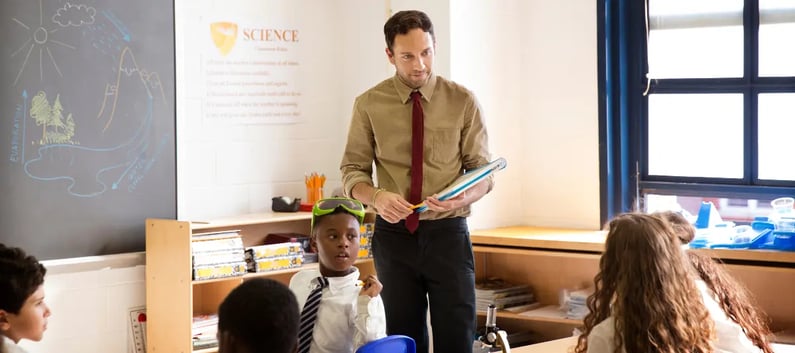
|
|
What the Health and Safety Executive (HSE) say... "When planning and providing play opportunities, the goal is not to eliminate risk, but to weigh up the risks and benefits. No child will learn about risk if they are wrapped in cotton wool." |
|
Though an element of risk will always remain, there are general measures to put in place, like a health and safety policy, as well as health and safety signs that serve as a reminder of what to do.
When designing a health and safety policy in schools, all location types (dining hall, sports field, classrooms etc) should be considered. By following the advice set out in the Health and Safety at Work Act 1974, you can outline practicable health and safety measures that can be followed by pupils and staff.
|
|
Health and Safety Training for INSET |
|
How is health and safety monitored and maintained in schools?
The school grounds is home to many different activities everyday. The risks associated with a Food Tech class vary greatly from those of rugby training on the sports field, and should therefore be monitored with their own set of measures.
Here we go through health and safety practices that should be considered around schools, and training that can help reduce the impact of these risks.
Health and safety in the playground
In the morning, break-time and lunchtime, children gather in the school playground to spend some time out of the classroom with their friends. From ball sports and ‘Forty Forty’ to conker wars and hopscotch, students are prone to getting cuts, bruises and grazes when enjoying their recreation.
For this reason, staff are required to supervise these areas, in case of illness or injury, so that they can either treat the student themselves or guide them to another first aider. Knowledge of how to carry out basic first aid is, therefore, essential for whoever is in charge.
|
First Aid Essentials in Education |
|
Your school should ensure that fully equipped and up-to-date first aid kits are easily accessible for staff to attend to any first aid needs of students, or other members of staff.
A Health and Safety Policy should consider how these types of injuries can be reduced. For instance, if the weather has been bad, the playground surface will likely be slippery or icy and so providing an indoor facility for the students to use during break-time or telling them not to run outdoors during these conditions will reduce the likelihood of a child falling over.
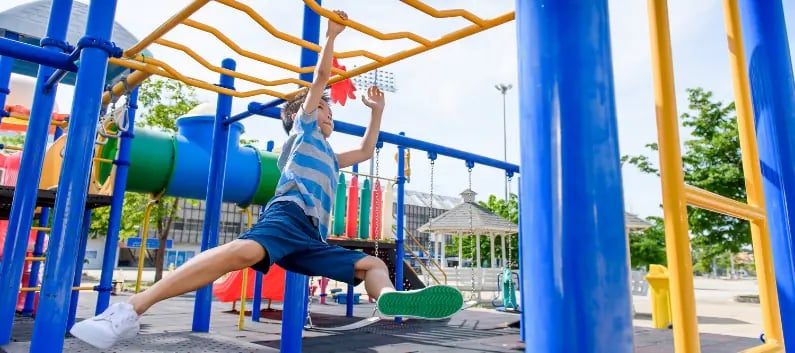
Health and safety in the classroom
General classroom health and safety precautions include making sure there is enough room between desks and other objects around the classroom to prevent people from tripping over or bashing into them, as well as allowing a swift route out of the classroom in the case of an emergency.
Electrical leads and cables should be hidden or covered from any path that students might use, whilst portable appliance testing (PAT testing), the inspection of electrical appliances that can be moved, should be regularly carried out by a qualified tester.
Classroom furniture, such as cupboards and bookshelves, should be secure, in good condition and not overloaded so that nothing can fall on somebody.
Maintaining these conditions within the classroom is also important. Classrooms should have natural ventilation and be kept at a reasonable room temperature when being used, whilst information on the presence of any asbestos in the school should be made known to members of staff.
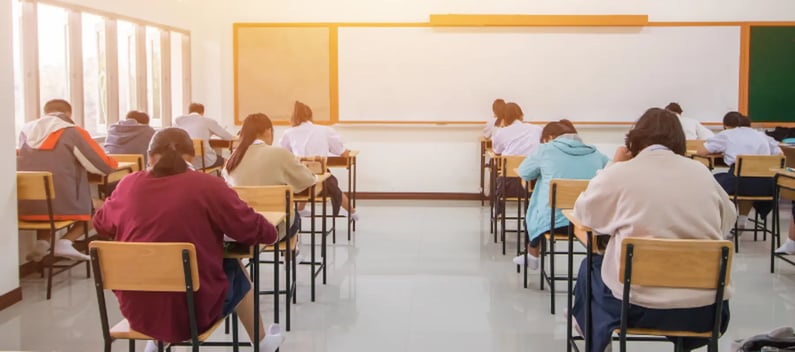
Health and safety in the science lab
Conducting experiments in the science lab often involves the use of harmful substances, including fire and chemicals. These can cause damage to students and teachers if the appropriate precautions are not taken.
When dealing with harmful substances, the teacher, who must be trained in using the equipment, should conduct a COSHH assessment and ensure the correct storage of these substances and equipment.
Measures to prevent harm to others may include ensuring there is a fully-serviced fire extinguisher, filling out a risk assessment for each class or experiment, and making sure the classroom is a safe space to navigate around, such as having enough room to get between tables. Moreover, pupils and staff must wear the correct PPE (personal protective equipment) at all times during experiments with substances that may threaten their health or safety.
|
|
Did you know... |
|
Fire safety is, of course, an important issue to account for in the laboratory and is one of the reasons the science laboratory is generally designed differently from other school classrooms. For fire prevention in your school, your risk assessment should identify what could cause a fire, for instance a naked flame with chemicals that burn, and who might be at risk.
Therefore, the appropriate fire extinguishers must be suitably located and easy accessible. If you're unsure about what type of fire extinguisher you might need around your school, we've written a fire safety guide on the 6 fire classes and 5 types of extinguishers.
.webp?width=795&name=Explore%20our%20Health%20and%20Safety%20for%20Education%20courses%20here%20(2).webp)
Staff and pupils must wear correct PPE when conducting experiments with harmful substances.
Health and safety in the ICT suite
Have you ever noticed that the school computer room is darker? Well, that's because the lighting recommendation for an ICT suite ('Category 2') is lower than for other classrooms in order to provide a suitable contrast between the computer screen and background environment. This is why you'll usually find blinds covering the windows in these rooms.
As highlighted by health and safety risks in the classroom, electrical wires should be boxed off so they are not be accessible to students. Computers and other electrical appliances found in the ICT suite need to be protected from exposure to liquids as spillages can lead to electrical fires. You should also beware of overloaded plug sockets or extension cables, which are a fire hazard.
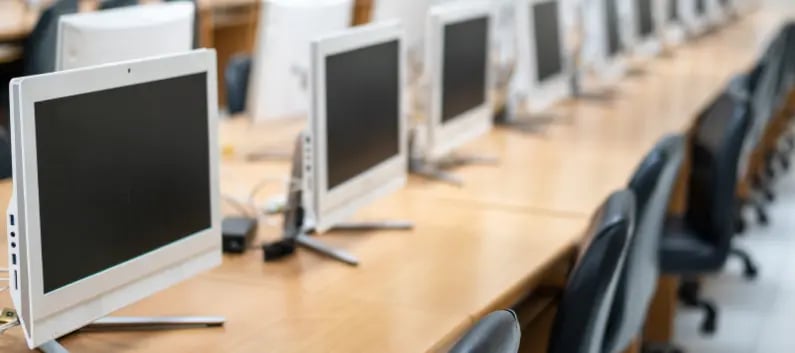
Health and safety in the dining hall
Allergies and other such intolerances to certain foods can lead to very serious health implications. Students and staff are likely to be aware of any allergies or intolerances that they may have, however, it is vital that the school also understands which individuals have specific dietary requirements and that these are provisioned, in order to provide protection from an emergency situation occurring, such as an allergic reaction.
|
Understanding Anaphylaxis |
|
Maintaining high food hygiene standards is also important in preventing food-borne illnesses and staff should be able to identify and spot symptoms of these illnesses. Food-borne illnesses are caused by contamination of foods and can occur at any point during food production.
Setting food safety and hygiene standards for your school can be achieved by following HACCP (Hazard Analysis and Critical Control Point) guidelines, which helps your organisation identify any critical control points to focus on in order to remove or reduce food safety risks to a safe level. Your food safety management procedures should also outline what action needs to be taken and records should be kept.
The combustion of cooking oils and fats present a fire risk, which can be treated with a Wet Chemical fire extinguisher (likely to be a different type of fire extinguisher than others around the school campus). The cooking staff have a duty to ensure the kitchen is well maintained with high food hygiene standards and general cleaning, for the purpose of both preventing cooking fires and promoting the health of students and staff eating in the school's dining hall.
.webp?width=795&name=Explore%20our%20Health%20and%20Safety%20for%20Education%20courses%20here%20(1).webp)
Health and safety on the sports field
Sports and Physical Education (PE) present a different risk for students. Unlike other classes, these activities are generally held outdoors (unless the school uses a sports hall as well).
Contact sports such as football and rugby are widely enjoyed in schools throughout the UK. They are not without their dangers, though. Injuries typically include bleeding and sometimes broken bones. Members of staff should be First Aid trained so that they can attend to these injuries immediately and that they are well-versed in the procedure of calling emergency services if needed.
|
Concussion in Schools |
|
Another injury that can occur whilst playing contact, and sometimes non-contact, sports is concussion. Treatment for concussion, which is a temporary injury to the brain following a blow or bump to the head, is even more urgent for babies, small children and teenagers as their brains are still growing.
.webp?width=795&name=Explore%20our%20Health%20and%20Safety%20for%20Education%20courses%20here%20(3).webp)
Health and safety during off-site activities
School trips are exciting occasions for students and staff. It's unusual, though, for teachers and parents not to worry about the safety of their kids leaving the school site. By making sure that every activity for the trip has been planned and risk assessed in advance, your school should be prepared to deliver a great day-out, or week away, with less stress.
As off-site excursions range substantially, it is difficult to lay out specific health and safety guidelines for schools. However, the significance of carrying out a rigorous risk assessment must not be understated.
|
Risk Assessment |
|
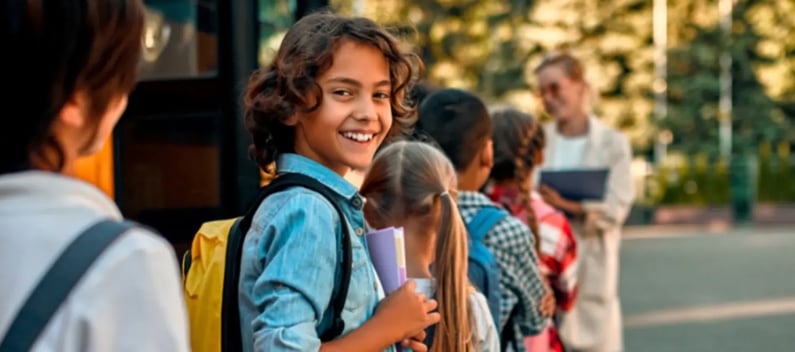
Health and safety in schools need not be a daunting prospect. With effective maintenance of school facilities and regular teacher training, which can be integrated into school INSET days, your pupils and staff can focus on enjoying the school day in a safe environment.
Find out more:
- Discover why webinars are a great teacher training tool in our article 'Why is webinar training so popular for school INSET days'
- Learn how to safeguard your students: 'A Guide for Safeguarding in Schools - Everything you need to know'
- Check out ALL of our Education Essentials training courses, keeping schools compliant and staff skilled.

-1.webp?width=243&height=74&name=Logo%20R%20Homepage%20White%20Final%20Horizontal%20Large%20NEW%20small%20(2)-1.webp)



-1.webp?width=50&height=59&name=Cyber%20Essentials%20Badge%20Large%20NEW%20(72dpi)-1.webp)
COMMENTS